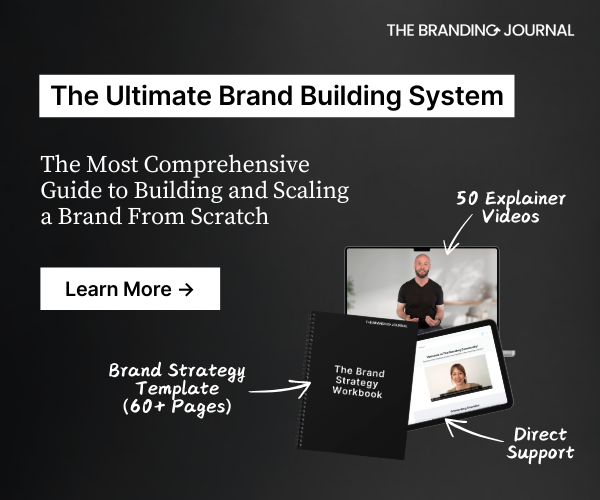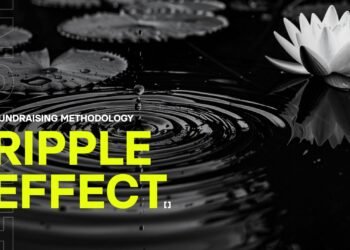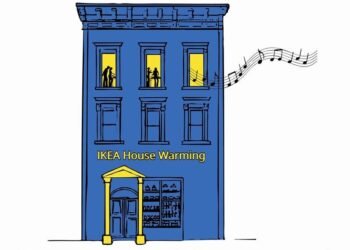If you glance below the cover page of most brand strategies, you’ll find the usual suspects: the brand’s purpose, its mission, audiences, positioning, identity foundations, and visual identity.
The fact is, there are several other crucial elements of a brand strategy that are often overlooked.
So today, we thought it would be interesting to share with you a selection of 15 questions we believe every brand strategy should answer, beyond the essentials.
They go beyond the surface to address what’s often missing.
Proven Systems for Business Owners, Marketers, and Agencies
→ Our mini-course helps you audit and refine an existing brand in 15 days, just 15 minutes a day.
→ The Ultimate Brand Building System is your step-by-step blueprint to building and scaling powerful brands from scratch.
1. What business are you really in?
Many people think their brand just sells a product or service, but often, they’re really selling something bigger, like convenience, a particular lifestyle, or sustainability. For example, a company may think it sells makeup, but it’s actually offering a daily ritual or a way to boost confidence. Defining what your brand truly offers helps shape a stronger strategy. So, before building your brand strategy, take the time to understand the market your brand fits into, not just in terms of industry but in terms of customer needs too.
2. Who are your brand’s stakeholders?
Marketing usually focuses on customers, but your brand touches a lot more people, and even the environment. Employees, investors, partners, communities, nature… they all care about what your brand does. If you take time to list these groups and understand what they need and expect, you’ll protect your brand’s reputation and make it stronger over time.
3. What do your target customers truly think and feel?
Don’t just look at your customers’ age or demographics. Think about what worries them, how they want to feel, what they hope for, and what frustrates them. When you understand these deeper needs, your brand can connect with people in a more meaningful way.
4. How are your competitors shaping the future of your industry?
Your competitors’ moves can tell a bigger story about where the market is headed. What long-term strategic direction have they chosen? Can this direction completely redefine your product category? Observe how they plan to innovate, shift, and influence the market so you can anticipate changes and find your brand’s path forward.
5. What events and cultural shifts could change your market in the mid- to long-term?
Society is always evolving. Social movements, technological advances, or economic changes can reshape your business environment. If you spot these early, you can adapt your strategy before disruption hits.
6. How can you elevate your brand’s ethical standards to impact customers, society, and the environment positively?
This part gets ignored way too often in brand strategy, and honestly, that’s a huge miss. If you actually work these questions into your branding, you set your whole company up to make things like sustainability and responsibility real priorities, not just buzzwords. Also, creating a positive impact on your customers’ lives and society is a strong way to keep your brand relevant for years to come!
7. What is your brand promise—what will you deliver no matter what?
Everyone talks about brand positioning and identity, but the brand’s promise often gets left out. If you had to explain a brand in just one sentence, it’s usually the promise you’d mention. This promise is the core commitment you make and keep every time, no matter what. It’s what customers come to trust and expect from you. Get the brand promise right, and you have something people remember and rely on. One of the most crucial elements of branding.
8. How do you want your brand to be perceived and experienced?
How people perceive your brand today might be very different from how you want them to perceive it tomorrow. Try to define what you would ideally like people to think and feel about your brand when they experience it. The emotional layer here is key. It will be the foundation of all your future brand identity work: its story, personality, communication style, tone of voice, visual identity, and more.
9. If your brand were a person, what would it be like?
This one goes beyond simply describing the brand with a few adjectives. The idea is to take some time to imagine the brand as a person, and describe its personality in a multifaceted way. Imagine the brand’s main personality traits, but also its thoughts, feelings, behaviours, and how it relates to people in the day-to-day. This will make it much more concrete and help you guide any future brand communication materials.
10. Are your products and services aligned with your brand identity and strategy?
A lot of people forget that a brand’s products or services are a big part of its identity (and that’s a huge mistake). Think about the last time you stopped buying from a brand because its product let you down. A “luxury” shirt that fell apart after three washes, a coffee maker that’s a pain to use, or rude service at a restaurant chain. What you offer should always match what your brand promises. If there’s a gap, customers will notice and lose trust. So if your products or services don’t line up with your brand, make it a priority to fix that.
11. Beyond visuals: will your brand use sensory branding?
Visual identity is important, and it’s usually the first thing people see in a brand. But sound, scent, touch, and even taste can also make your brand more memorable. These extra details add texture to your brand’s experience and help people connect with it in new ways. Think about which senses could add something special for your audience and make them part of your brand’s identity.
12. How can you ensure every communication touchpoint reflects your brand identity?
Think of this as a quick action plan to keep your brand consistent everywhere people interact with it. Every touchpoint (like your marketing, customer service, packaging, and social media) should match your brand’s strategy and style. The goal is to create a seamless, recognizable experience so your brand always appears professional and remains true to its claims.
13. Is your brand strategy fully understood and lived by all teams?
Branding is not something that only belongs to the marketing department. Your brand is everyone’s job: from sales, to HR, to CSR, to supply chain, and it’s important to make sure every team knows the strategy and acts in ways that support it.
14. How can you make your brand more famous?
Working on your brand is great, but it only makes sense if people can discover and engage with it! Making your brand visible is a crucial part of your brand strategy, and it’s also what we call building “brand awareness”. It helps you reach new audiences, build trust through regular encounters and interactions, and create more opportunities to grow your business. So, what could you do to increase your brand’s visibility in the short, medium, and long-term?
15. What are the top three metrics to measure progress and impact?
Without clear measures of success, it’s hard to know if your strategy is working. We recommend keeping it simple and choosing 2-3 metrics that will help you measure how your brand is perceived and experienced, its fame, and the level of loyalty it inspires.
Final Thoughts and Next Steps
These questions highlight what many brand strategies miss: some of the deeper layers that build trust with all stakeholders, create emotional connections with customers, and prepare your brand for the future. If you haven’t explored these areas yet, now is the perfect time to start.
And if you want to cover both the basics and these deeper questions in a clear, step-by-step way, our online course is designed precisely for that. With 50 explainer videos and our over 60+ pages brand strategy template, it’s ideal for marketing specialists and consultants who want to build strong, comprehensive brand strategies.
Proven Systems for Business Owners, Marketers, and Agencies
→ Our mini-course helps you audit and refine an existing brand in 15 days, just 15 minutes a day.
→ The Ultimate Brand Building System is your step-by-step blueprint to building and scaling powerful brands from scratch.


















